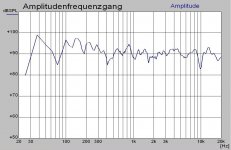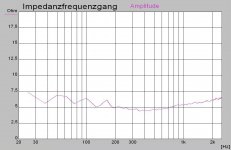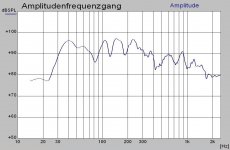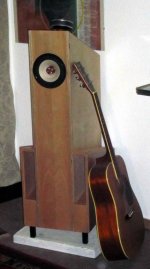kangling
samuel,
give a link,
the Fostex http://www.fostexspeaker.de/fullrange/fesigma/fe168ez.pdf
is a good front driver, for the high ton exact position is needed.
give a link for your other driver.
hallo IVO,
z.B. for the Posaune variationen you need only tripel part C and you can use 9 mm
may be a few mm with thick paper.
also possible in Kangling or RDH20 during the building prozess it is easy to manage
such differs of material.
the main sound difference of material in your case might be the transmission of sound
through the material, i like it 30 y ago i made my walls with Kork, good material around
the front wall of the speaker.
a enclosure made of Kork i never try, also soft fibre,
i think the enclosure need a stiff outside.
samuel,
give a link,
the Fostex http://www.fostexspeaker.de/fullrange/fesigma/fe168ez.pdf
is a good front driver, for the high ton exact position is needed.
give a link for your other driver.
hallo IVO,
z.B. for the Posaune variationen you need only tripel part C and you can use 9 mm
may be a few mm with thick paper.
also possible in Kangling or RDH20 during the building prozess it is easy to manage
such differs of material.
the main sound difference of material in your case might be the transmission of sound
through the material, i like it 30 y ago i made my walls with Kork, good material around
the front wall of the speaker.
a enclosure made of Kork i never try, also soft fibre,
i think the enclosure need a stiff outside.
The best enclosure I built was a sealed box made of cork, with a cube of thin birch plywood around it, filled entirely with sand. It damped, it was rigid, it was heavy. The little driver I am using now is already better, so while making the current enclosures I never bothered to add the sand. Maybe I should.
Here is the link to my other driver The Madisound Speaker Store In a Quarter Wave Tube I get very good response from about 26Hz in almost any room with this driver. Thanks for your information and interest.
Thanks. Any problem if the driver is 4 ohms and I have a dedicated amp for each of the two drivers per horn?
Hello Sam,
than you don´t understand the double horn technic,
the driver MUST be connected parallel. Bi Amping no.
than you don´t understand the double horn technic,
the driver MUST be connected parallel. Bi Amping no.
Sorry, I will have to study the technique of the double horn a little more. But here is the link to the 8 ohm version of the driver The Madisound Speaker Store What F3 can one expect in the proposed double horn? What about difference in sensitivity of the drivers?
Hello Sam,
the driver would work as back driver invers.
F3 in 22 qm room ~35 Hz, like the other double horns.
In Kangling case 89 dB for the back driver is enough,
with more SPL you will need a notch filter in the mids.
the driver would work as back driver invers.
F3 in 22 qm room ~35 Hz, like the other double horns.
In Kangling case 89 dB for the back driver is enough,
with more SPL you will need a notch filter in the mids.
sam,
i would test two of the 8 Ohm version, one invers , changed + -,
for both a 6 dB crossover ~1-2 kHz 4 Ohm , and on top over the front driver
take a AMT with 4-6 kHz 6 dB crossover, spl ~91 dB,
this could be a cheap version, the sound in the mids depents on your driver.
i would test two of the 8 Ohm version, one invers , changed + -,
for both a 6 dB crossover ~1-2 kHz 4 Ohm , and on top over the front driver
take a AMT with 4-6 kHz 6 dB crossover, spl ~91 dB,
this could be a cheap version, the sound in the mids depents on your driver.
yes, we made measurements, but it takes a few days.
i am very happy no filter is needed and i never saw an Imp like that, flat 4 Ohm
no bassresonanz down 35 Hz, for me one of the best low level classic playing speaker.
next week i will show and write something, compaired to the MINI-Posaune
http://www.diyaudio.com/forums/full-range/249361-mini-posaune.html
i am very happy no filter is needed and i never saw an Imp like that, flat 4 Ohm
no bassresonanz down 35 Hz, for me one of the best low level classic playing speaker.
next week i will show and write something, compaired to the MINI-Posaune
http://www.diyaudio.com/forums/full-range/249361-mini-posaune.html
Great...I will propably do the Kangling anyway,
if the plans will be available. I bought the saxophone but would like
to do this project...
I assume whit sonido SFR175 and monacor the impect on impedance will
be a little different...
if the plans will be available. I bought the saxophone but would like
to do this project...
I assume whit sonido SFR175 and monacor the impect on impedance will
be a little different...
Those look pretty good - is there a reason why your measurements have such coarse resolution in the low frequencies? I can't tell how wide the 75 Hz dip is as it may just be data point resolution limited. Try the REW software - it works very well and is easy to use and produces very nice plots. That is an amazingly flat impedance curve but again more resolution in the low freq will really tell how flat it is or is it just data point resolution smoothing going on.
Ha Ha
today i use a cheap chip amp, 2x 15W
for normal listening you need <0,3 W
max. ~ 5 w impuls ~ 100 dB ~ 1,5 mm stroke.
i never heard a fullrange which sounds good if the stroke is >1,5 mm
so small amps >3 w will do it, because of the IMP, Tube amps will love the speaker.
today i use a cheap chip amp, 2x 15W
for normal listening you need <0,3 W
max. ~ 5 w impuls ~ 100 dB ~ 1,5 mm stroke.
i never heard a fullrange which sounds good if the stroke is >1,5 mm
so small amps >3 w will do it, because of the IMP, Tube amps will love the speaker.
- Status
- Not open for further replies.
- Home
- Loudspeakers
- Full Range
- Kangling double horn technic



